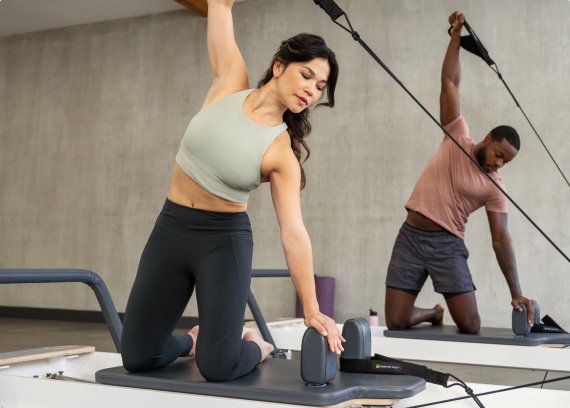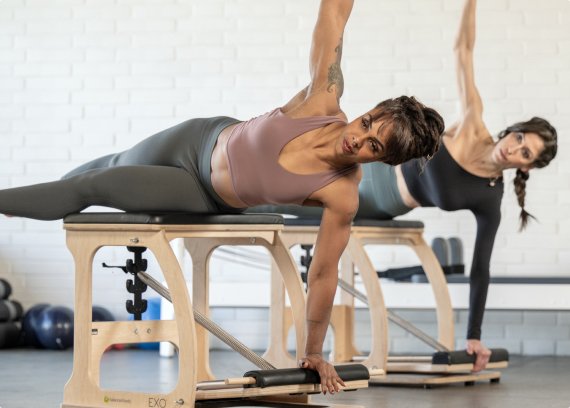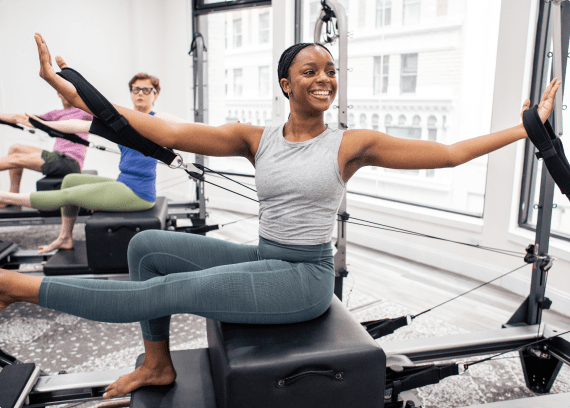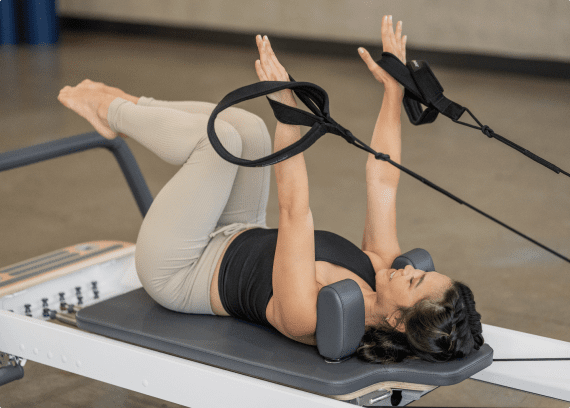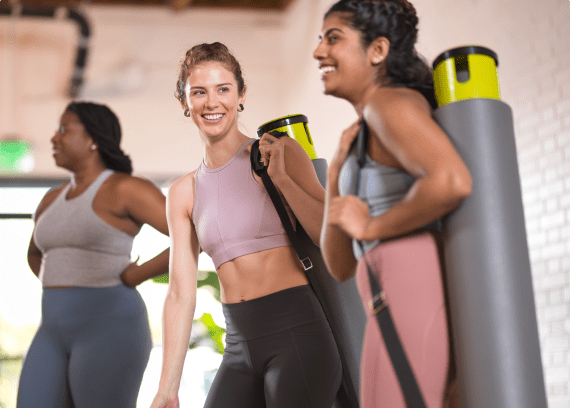Little Movers:
Pilates for Children with Neuromuscular Disorders
Little Movers:
Pilates for Children with Neuromuscular Disorders
By Christine Egan, MPH, PT
Pilates-based treatment is flourishing throughout the ranks of physical therapy and rehabilitation. It’s become a popular method to treat a variety of orthopedic injuries, along with age-related ailments such as osteoporosis.
Now, Pilates has also become an effective mode of therapy for a new patient population — children with neuromuscular disorders. As a pediatric physical therapist with a background in neurodevelopmental treatment (NDT), I began to incorporate Pilates into my practice after taking classes in the exercise and becoming a certified instructor. Pilates incorporates many principles of NDT, and has been a strong asset to the way I approach my young patients.
How is Pilates for Rehabilitation Different?
Pilates for rehabilitation purposes is different than Pilates as a general conditioning tool. Many of these differences center on modifying the exercises to meet the needs of a specific patient. It requires a more intuitive mindset and the critical reasoning skills of an experienced therapist to identify the objectives that will create a positive movement experience.
Even more specifically, Pilates for children with neuromuscular disorders — such as cerebral palsy or hypertonia — differs from Pilates for general rehab. Therapists working with this unique group must understand the social, emotional, behavioral and developmental implications of neurological damage, and how to harness Pilates principles to counteract these effects.
Pilates for Children Neuromuscular Challenges
Children with neuromuscular challenges have difficulty modulating an appropriate balance of flexion and extension. While a healthy motor control system acts like a dimmer switch your body automatically knows what percentage to flex or extend an affected neuromuscular system is more like an on-off switch. For example, the knee is either straight or bent.
Using the Reformer
Reformer work is an effective way to teach these children how to control their own movements. They receive resistance from the equipment and feel the contact with the foot bar or jumpboard, which provides a better sense of where their body is in space as they move through a variety of positions.
The Reformer is also a good way to harness the power of the supine position. Many children can’t hold their bodies against gravity, as they lack the alignment and muscle power to stay upright. The supine position allows these children to move with greater ease and control, which contributes to a positive movement experience.
When it comes to therapy equipment, size is a frequent concern for the pediatric therapist. Standard equipment must be adapted to accommodate smaller bodies. Various heights of Reformers are now available for this purpose, as well as foot bar options that accommodate smaller clients. In addition, shoulder blocks can decrease the space between the shoulder rests and the foot bar for a better fit. I often use pillows, towels and other items to secure the child on the carriage.
Having a jumpboard — a flat board attached to the foot-end of the Reformer — is a must. This flat surface enables children to initiate movements in the supine orientation. Also, children with severe conditions often can’t maintain their feet in a fixed position, so an elastic fastener affixed to the jump board and the soles of their orthopedic sandals adheres them to the board, facilitating knee flexion and extension.
Finally, a standing board can make more advanced standing abduction and balance work possible.
Pilates for Neurological Rehabilitation Case Studies
Here are two examples of how Pilates can be used as part of a comprehensive neurological rehab program.
Pilates for Toddler with Muscle Weakness and Delayed Motor Development
A 2-year-old boy with an unknown diagnosis presented to our clinic with overall muscle weakness and delayed motor development. He was only able to ambulate with the assistance of a walker, or by pushing a cart. His legs were very stiff during gait as he attempted to maintain stability.
Our goals with this patient were to improve active hip and knee flexion during gait, and improve graded muscle control in his lower extremities to allow more mid-range control during transitions and bending.
First, we adapted the Reformer by setting the foot bar at its closest position and placing a large firm pillow at the headrest and shoulder pads. Holding his feet onto the bar and using the lightest resistance spring, we guided him through simple flexion and extension movements.
I then assisted him by gently pushing the carriage as he extended and resisted it on the return, so he could feel a slow, controlled, eccentric contraction. We took that into unilateral flexion and extension.
Our program for this patient progressed to include:
- legwork on the bar
- trunk stabilization/bridging
- trunk stabilization with active hip flexion, extension, abduction and adduction with assistance
- “elephants” (active hip extensions)
- modified "mermaids" for trunk flexion and rotation
- modified rowing/pulling straps
- standing splits with assistance
In addition, this boy used bilateral AFOs to maintain stability and foot and ankle alignment, and an undergarment orthotic strapping system to improve body awareness and postural control. He’s now able to move the Reformer carriage smoothly and without assistance.
Pilates for 10-year-old After Surgery to Remove Brain Tumor
A second case study involves a 10-year-old girl who underwent a brain resection to remove a rare tumor at age 2. Following the surgery, she presented with marked right-side weakness of the upper and lower extremities, with distal spasticity in her wrist and ankle. To address the hemiparesis, we focused on bilateral activities and targeted work on the involved lower extremity.
Ankle range of motion movements using the foot bar is a simple way to use Pilates with children with neuromuscular disorders. Manual therapy to lengthen shortened structures while the foot is in a weight-bearing position on the Reformer is another effective technique.
Specific Pilates exercises that we prescribed for this patient involved:
- leg work on the foot bar
- unilateral flexion and extension
- jumping on the jump boards
- "elephants,"
- trunk stabilization with leg straps
- standing spring work
- gait training and upper extremity strengthening
The program has proven effective for this patient, and her motor deficits are now barely noticeable.
Summary
The concepts of core strength and stabilization are critical for both children and adults with a neuromuscular or tonal disorder. Providing alignment, resistance and assistance during difficult movements helps them learn new movement patterns. Understanding Pilates concepts, as well as your own movement education by doing the movements yourself, will open your treatment repertoire to an effective means of achieving the best outcomes for clients of every age.
About the Author
Christine Egan is a pediatric physical therapist with over 25 years of experience in the field of pediatric rehabilitation. Educated at Hunter College in New York, Christine spent the first decade of her career working with and learning from some of the best therapists in the world. Her training includes NDT certification, orthotic evaluation, casting and fitting, TES training, Kinesiotaping, and a host of manual techniques including craniosacral therapy. She began doing Pilates 17 years ago to maintain and strengthen her own body. Over the years she has modified and applied the principles of Pilates exercise to address the sensory-motor needs of children with orthopedic and neuromuscular disorders. A life-long learner, Christine continues to develop her skills and design programs for children that improve the overall quality of life for her clients and their families.
From the September 1, 2006 issue of Advance for Directors of Rehabilitation

